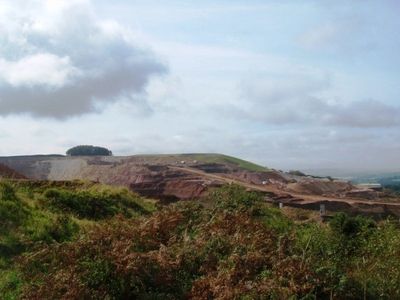Drakelands Tungsten Operation : Wolf Minerals

In September 2015 extraction commenced at Drakelands tungsten operation, a large open cast mining facility developed to mine extensive reserves of tungsten ore close to the village of Hemerdon, near Plymouth. Wolf Minerals Ltd, an Australian based consortium was set up to finance and develop the operation. Prior to work commencing at the site a host of environmental licences, including abstraction, impoundment and discharge licences, were applied for with the Environment Agency (EA) and planning permission sought. The proposed operation was to develop and greatly expand the existing mining facilities at Hemerdon which had been abandoned in the 1970s.

The Smallhanger Brook flows through the proposed development, with much of its middle catchment contained within it. The catchment of a second watercourse, the Hooksburry Stream, also lay within the development area, in a small wooded valley in which it was proposed to construct a large storage reservoir to supply water to the mine and for dusting down operations. This would entail the removal of most of the stream's length and diversion of the flow through the reservoir, into a new compensation flow channel. As part of a large suite of other environmental surveys, there was a requirement to carry out surveys of the aquatic invertebrate communities at several sites along the Smallhanger Brook and on the Hooksburry Stream, in order to assess their conservation value and to provide base-line data prior to the development taking place.

To this end, two base-line surveys were undertaken in 2008 and 2011. The first survey sampled seven sites on the Smallhanger Brook in the vicinity of the propsed mine workings and lower on the catchment where a new road was to be constructed to improve access, as well as a single site on the Hooksburry Stream, just upstream of its confluence with the Tory Brook. During 2011 the survey was expanded to include a further five sites on the Tory Brook, into which the Smallhanger Brook also flows. This was due to the proposal to construct a pump house and weir on the Tory Brook in order to abstract water to maintain levels in the proposed reservoir.
Following approval for the development and granting of the required licences, a Unilateral Undertaking, which was subsequently incorporated into a Modification Order, was granted on 4th January 2011 and construction of the pit and extensive ancillary development, including the aforementioned reservoir, the ore processing plant and mine waste facility was carried out during autumn 2014 and 2015, with construction of the reservoir completed in 2015. As part of the Unilateral Undertaking, the EA required a cycle of monitoring of the aquatic invertebrate communities in the three watercourses in order to assess any potential impacts on the receiving waters during the course of the mine's operation. Initially the monitoring was to take place over a five year period, from 2013 to 2017, although this was extended into 2018, until the mine's closure in October 2018. During the 2016 monitoring cycle, an additional site was added on the Smallhanger Brook and a second site on the newly constructed Hooksburry Stream compensation channel, in order to monitor its development into a more natural stream habitat and its subsequent colonisation by a diverse aquatic invertebrate assemblage. Plans to re-start the mining operation in 2022, under the management of the newly constituted company Tungsten West Ltd. have led to the programme of environmental monitoring re-commencing in that year.
In each monitoring year aquatic invertebrate samples were collected in both the spring (May) and autumn (September) seasons with a report detailing each of the year's results, and comparison with previous surveys, produced after subsequent analysis of the samples. This report was sent to Wolf Minerals, who then passed it on to the EA for review. The report analysed the data using a suite of biotic indices widely used by the EA, including: BMWP, WHPT, CCI and LIFE scores as well as analysis of the data using RIVPACS IV, embedded within the RICT (River Invertebrate Classification Tool) website, to note any changes in the indices from the base-line values calculated during the 2008 and 2011 surveys and to provide a classification of the ecological status of the various monitoring sites.
